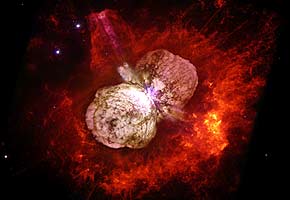Spotting “Twins” of Superstar Eta Carinae
Astronomers looking for clones of a massive and famously unstable star in the southern sky.

Glowing within the far-southern Milky Way, the Carina Nebula (NGC 3372) harbors an astrophysical enigma: the dust-shrouded, wildly variable star Eta Carinae.
Were it not sequestered deep in the southern sky, Eta Carinae would surely be more famously known. It's one of the most massive stars in the Milky Way, estimated to have 120 Suns' of material. Together with its companion star, Eta Car pumps out more than 5 million times more energy than the Sun — a luminous output that should make it a dazzling nighttime beacon.
Instead, this beefy binary hides out inside a double-dumbbell of dust and gas, called the Homunculus Nebula, which mysteriously spewed forth in the 1840s in what's known as the Great Eruption. That's when Eta Car briefly became the second-brightest star in the sky.
Astronomers haven't seen any stars quite like Eta Car, but they want to. Such massive, evolved stars created many of our galaxy's heavy elements, such as the iron in our blood and the oxygen that we breathe. Shrouded in dusty shells of gas thrown off as they come close to death, these megastars might also be the culprits behind what are called superluminous supernovae — which are basically exactly that: anomalously bright stellar explosions.

This Hubble Space Telescope image shows the hourglass-shaped Homunculus Nebula that surrounds the supermassive star Eta Carinae. In the 1840s, Eta Carinae suffered a violet eruption that ejected the Homunculus. The star is surrounded by so much material that we cannot see its surface, even though it shines with the energy of 5 million Suns. It is 7,500 light-years from Earth.
Observers haven't had much luck looking for Eta Carinae's twins. Some searches have turned up hints of ejected nebulae, others bright stellar outbursts like the fitful Great Eruption. Although the latter observations have yielded several candidates, these outbursts vary in intensity and duration too widely to make them good analogs to the unstable behemoth in our immediate stellar neighborhood (well, if you consider 7,500 light-years close by).
A team led by Rubab Khan (NASA Goddard Space Flight Center) is taking another tack, by searching for dust-enshrouded stars whose visible and infrared light matches Eta Carinae's. Their previous work turned up 18 candidate objects in nearby galaxies, but none of these turned out to be a similarly massive, evolved star.
Now, the team has moved farther out, looking at four bright, star-forming galaxies that lie 15 to 26 million light-years away. These targets — M51, M83, M101, and NGC 6943 — are all spiral galaxies burgeoning with young, massive stars. Together, they've produced 20 of the Type II (core-collapsing, big-star-killing) supernovae seen in the last century. And here is where the astronomers found what they were looking for: five candidates that look just like Eta Car.

The spiral galaxy M83 hosts two potential "twins" of the supermassive star Eta Carinae. These candidates, shown in the insets, seem to have warm, dusty shrouds that make them more detectable at mid-infrared wavelengths than in visible light. The Hubble Space Telescope recorded all three images.
NASA / ESA / Hubble Heritage Team / R. Khan
NASA / ESA / Hubble Heritage Team / R. Khan
In this case, "look just like" is used loosely. The five objects are so distant that instruments cannot resolve any details — each star would be only a tiny fraction of a pixel across, Khan explained yesterday during a press conference at the American Astronomical Society's biannual meeting. But the light coming from these sources behaves just like that from Eta Car.
The sources are relatively faint in near-infrared and visible light, as seen by the Hubble Space Telescope, but they're bright at mid-infrared wavelengths, as seen with the Spitzer Space Telescope. Plus, their brightness "flattens out" in this mid-infrared range, in a manner that's a spot-on match for dust surrounding a star that's been warmed to between 400 and 600 kelvin.
Thus, the team members are pretty sure they're seeing light from massive, evolved stars. However, such stars generally exist in crowded environments, and because the Hubble and Spitzer images lack the spatial resolution to disentangle what's there, the details are ambiguous.
Khan readily admits that lots of questions remain unanswered: Are these stars in fact at the same stage of development as Eta Car? Are they binaries? Did they lose all the dusty material around them at once, or over time?
Stellar astronomer Nathan Smith (University of Arizona) says one downside to this detection method is any next-step studies might have to wait. Spitzer exhausted its cryogenic coolant in 2009, so it can no longer observe all the wavelengths that Khan's team used to match these objects with Eta Car. And they're too too faint for ground-based telescopes. The infrared-optimized James Webb Space Telescope, slated for launch in 2018, will hopefully give a boost to this type of study.
One interesting tidbit: galaxies with low abundances of heavy elements (broadly called "metals" by cosmologists) tend to form more high-mass stars. Yet these four galaxies all have high metallicities. Khan hopes to now look at other metal-poor galaxies to see if they contain these stars, too.
No comments:
Post a Comment